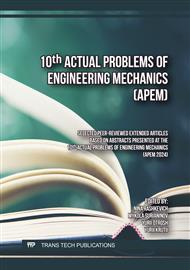p.19
p.27
p.35
p.43
p.53
p.63
p.73
p.79
p.85
Spatial Organization of Thermal Processes during Structure Formation of Composite Materials
Abstract:
The paper discusses the results of studying the hardening process of a gypsum-based composite material using a thermal imager. Thermal imaging research involves periodically obtaining thermal images of hardening material with pronounced hydration exotherm. It is assumed that the intensity of hydration and heat release depend on the state of the heterogeneous system, the structure of the forming material and the degree of aggregation of particles of hydrating components. The resulting images contain both visible and hidden information about the physical and chemical processes occurring in the material. To fully obtain such information, computer image processing methods were used. Intensity histograms were constructed and analyzed, for which regular changes were observed in the process of structure formation. As a generalization of the observed patterns, a working hypothesis is proposed about the filling of scales of physicochemical characteristics and, in particular, large-scale structural scales, in the process of structure formation. An image processing algorithm has been developed that makes it possible to construct isothermal cells‒areas of material with the same temperature. The geometric characteristics of the resulting areas, forming a partition of the study area, were studied by an automated method and reflected using histograms. The interpretation of the influence of a changing temperature distribution on the properties of a material is based on the idea of an approximate correspondence between a network of temperature cells and a Voronoi network that defines regions of a disordered structure. The spatiotemporal features of thermal processes are considered, indicating a possible decrease in the strength characteristics of the material.
Info:
Periodical:
Pages:
53-61
Citation:
Online since:
December 2024
Keywords:
Price:
Сopyright:
© 2024 Trans Tech Publications Ltd. All Rights Reserved
Share:
Citation:



